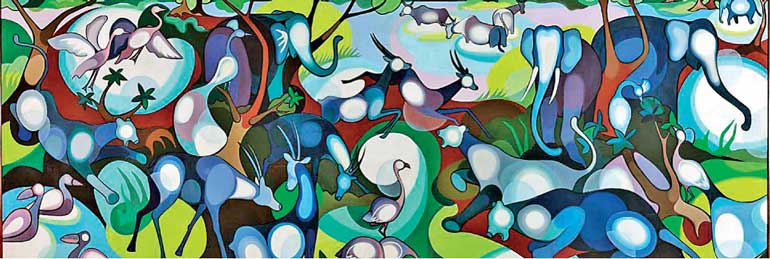Saturday Mar 15, 2025
Saturday Mar 15, 2025
Saturday, 23 April 2022 00:00 - - {{hitsCtrl.values.hits}}

A review by Arun Dias-Bandaranaike
Confluence, conflict, confusion and comprehension – were literary ‘signals’ that flowed through my consciousness, as I perused the exhibits at this presentation, “Encounters”, hosted by the Museum of Modern and Contemporary Art Sri Lanka (MMCA) .
Let me begin with ‘comprehension’. Ceylon, in the 20th century, was headed toward its own self-discovery and the vanguard was formed of artists, writers and creative souls with different motivations, facilities, ability and levels of awareness of history, and geography; convinced as they were, of the relevance of this island in the firmament of world culture. The exhibition compellingly presented evidence these creative energies belonged to intellectuals; persons imbued with a sense and a purpose.
I was made aware that in as much as there was Tagore in Bengal, and W.E.B. du Bois defined the spirit of the Harlem Renaissance and its Afro-American variety, Ceylon too, had compelling personalities who drew, painted, sculpted and wrote, effectively calling attention to the uniqueness of the land on which they strode.
Those individuals whose work was selected to represent the period following ‘independence’, had sought to find confluence after the rupture of empire, and they formed alliances and sought fresh avenues to reach out to more of the world than was found in the Atlantic power-alliance and ‘old’ Europe and the colonial experiments, which had wrought much influence in this island over several centuries. In art, as early as in 1943, the now famous group of painters had already charted a course that recognised the ethos of the people of Lanka. Samples were included of George Keyt and also Aubrey Collette’s telling “social commentary” through art. The earthy impact of Richard Gabriel’s singular style impacts his own narrative.
In their own way, they dealt with the conflict and confusion in the self-identity of Lanka as an emerging ‘nation’. “Encounters” also powerfully projects the idea that long since 1948, the land is still beset by the same unstable tectonics and fractured fault-lines. The sometimes hideous and generally egregious cultural divisions and class-consciousness, privations and exclusion of segments in what could be a unified society, remain as saddening subjects of several of the works of contemporary artists, and, the symbols of culture such as the “Lotus” are given a degree of treatment fore and aft. The Bandung conference in the 1950s (Collette’s take) was the issuing of the call to make something of a once-colonised polity, with its own signature, and similarly in 1976, the same energy was on display, as Non Aligned nations strove to grapple with inequity both in geo-politics and the economics of the ‘south’ and convened in Colombo. Martin Wickramasinghe’s pithy prose (Viragaya) contributed its own clarity of vision, and the efforts of Ratna Deshpariya Senanayake, through his contra-colonial leaning, built a body of significant work under the Afro-Asian Writers’ Bureau of which he was a prime mover. He was one who also linked with the academics of W.E.B. du Bois’ widow, who continued to nourish the legacy of the African sensibilities and pride in negritude awakened by her husband in the 1920s.
How wonderful that these disparate elements are found in the same space at ‘Encounters’ at the MMCA Sri Lanka located at Crescat Boulevard, Colombo 3. Viewers at MMCA Sri Lanka will be rewarded with seeing what Ceylon was and how much of the same prevails in ‘Sri’ Lanka or is lost.
Discover Kapruka, the leading online shopping platform in Sri Lanka, where you can conveniently send Gifts and Flowers to your loved ones for any event including Valentine ’s Day. Explore a wide range of popular Shopping Categories on Kapruka, including Toys, Groceries, Electronics, Birthday Cakes, Fruits, Chocolates, Flower Bouquets, Clothing, Watches, Lingerie, Gift Sets and Jewellery. Also if you’re interested in selling with Kapruka, Partner Central by Kapruka is the best solution to start with. Moreover, through Kapruka Global Shop, you can also enjoy the convenience of purchasing products from renowned platforms like Amazon and eBay and have them delivered to Sri Lanka.
Discover Kapruka, the leading online shopping platform in Sri Lanka, where you can conveniently send Gifts and Flowers to your loved ones for any event including Valentine ’s Day. Explore a wide range of popular Shopping Categories on Kapruka, including Toys, Groceries, Electronics, Birthday Cakes, Fruits, Chocolates, Flower Bouquets, Clothing, Watches, Lingerie, Gift Sets and Jewellery. Also if you’re interested in selling with Kapruka, Partner Central by Kapruka is the best solution to start with. Moreover, through Kapruka Global Shop, you can also enjoy the convenience of purchasing products from renowned platforms like Amazon and eBay and have them delivered to Sri Lanka.